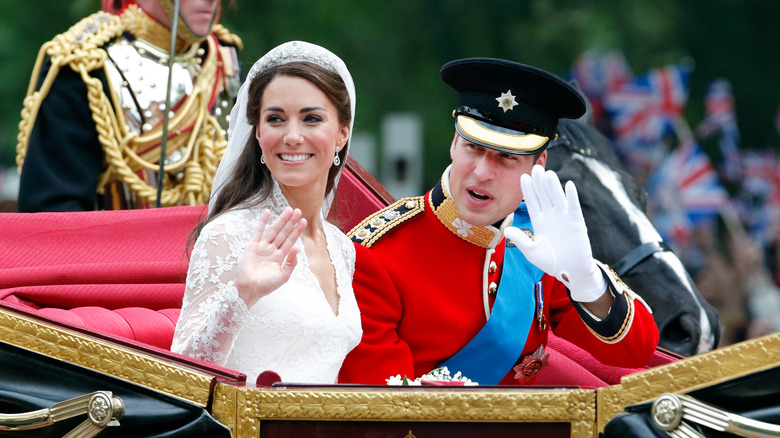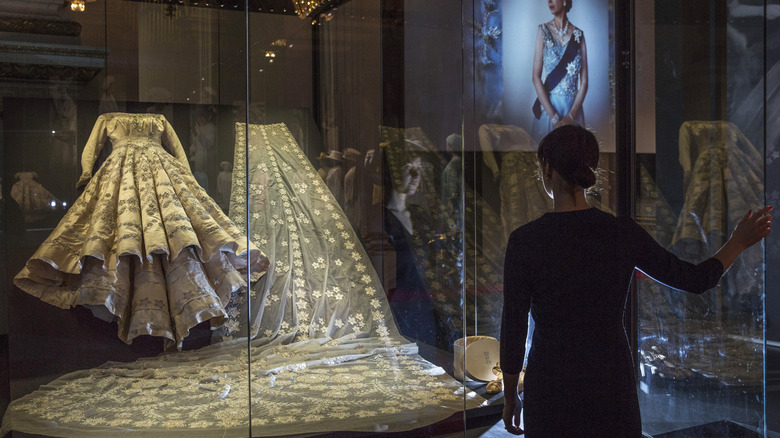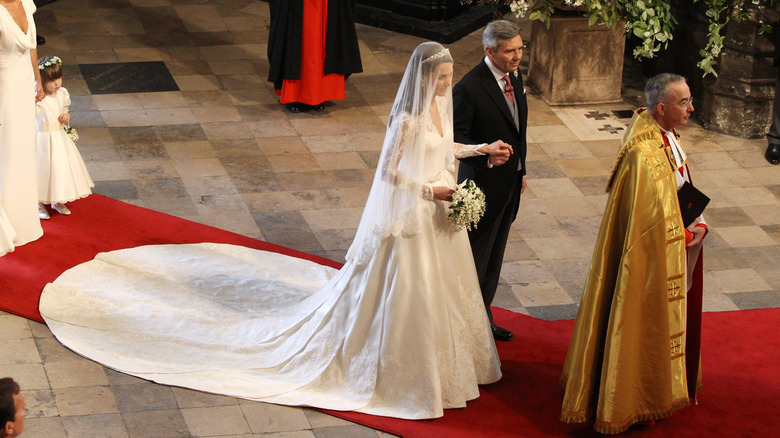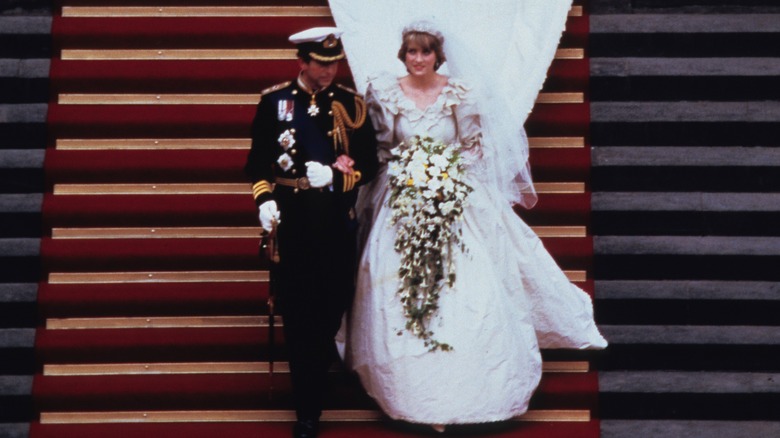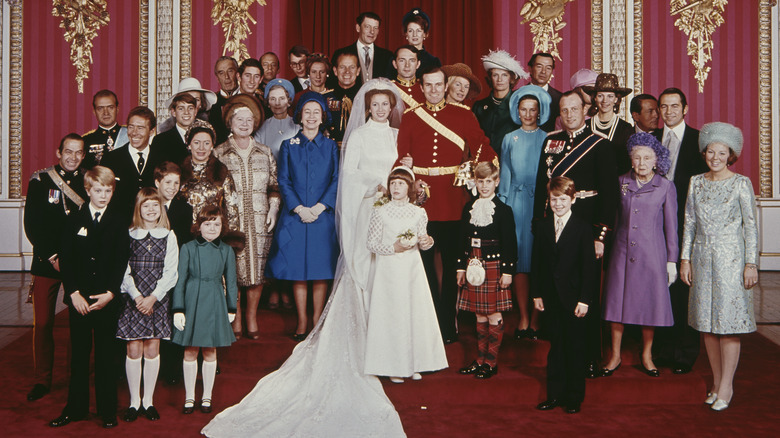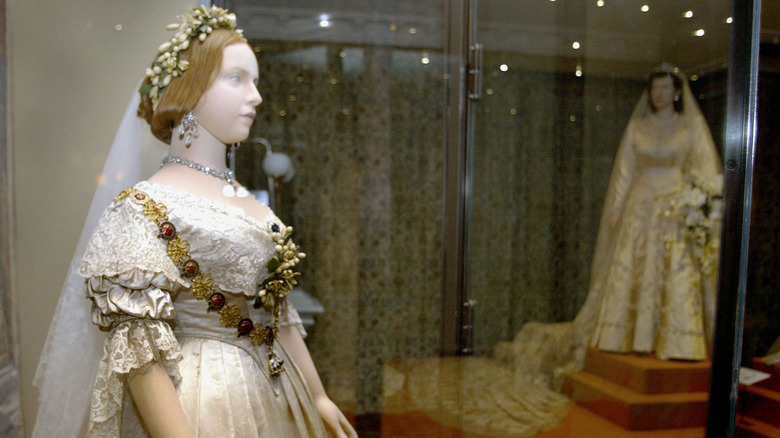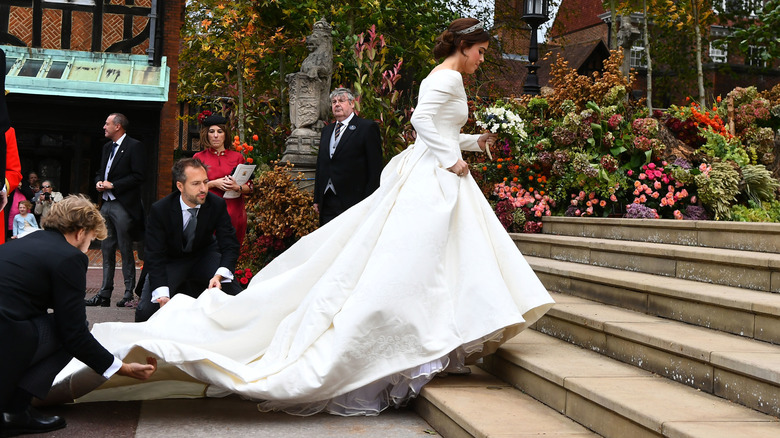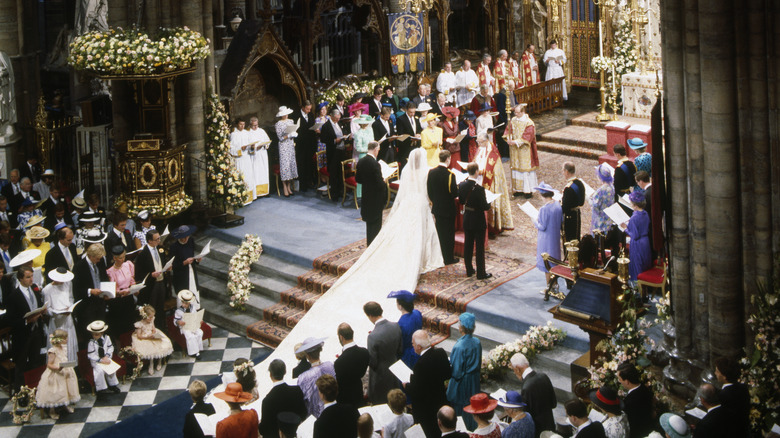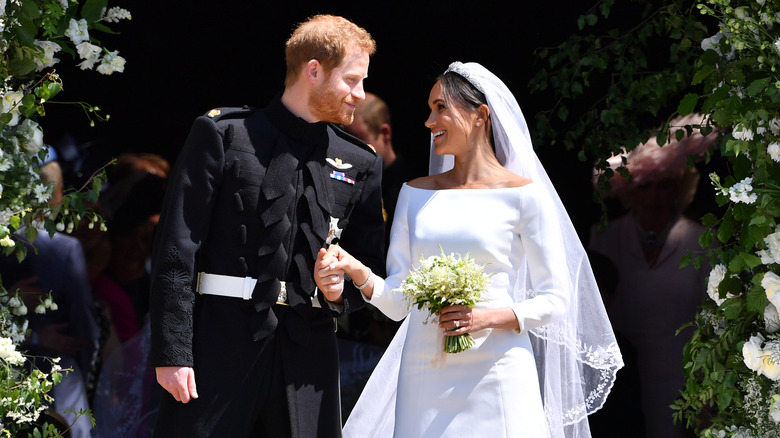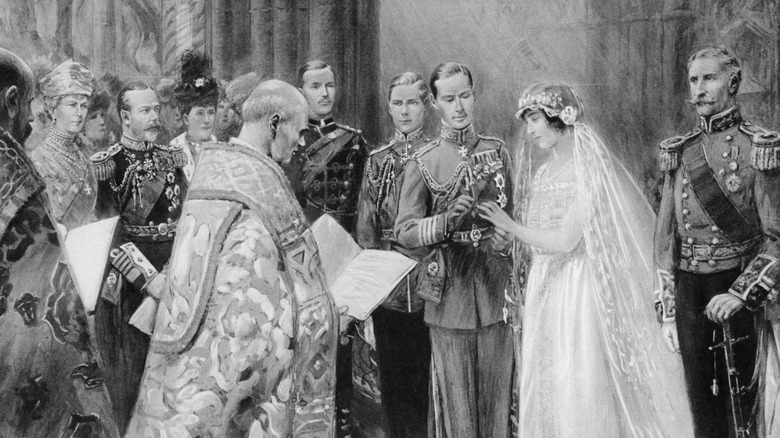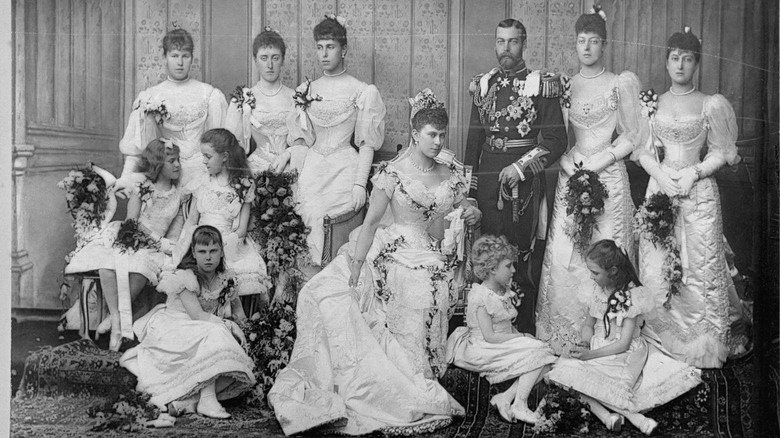Royal Wedding Dresses That Hid Secret Messages
There is no single characteristic that defines a royal wedding more than the royal wedding dress. Royal wedding gowns are breathtakingly magnificent, and serve as fantasy in motion for adoring observers around the world. Once a royal wedding dress has been commissioned, the design and completion can take months, and no detail or tradition is spared or overlooked. Kensington Palace revealed that staff who handled the embroidery of the Duchess of Sussex's veil had to wash their hands every 30 minutes to preserve the pristine state of the materials.
When the bride and the designer begin the process, the tradition and symbolism of every royal wedding of the past are considered. Each attribute of the dress reflects the bride and groom, and often symbolizes every royal wedding that has come before them. Today's modern royal brides are still following traditions set by Queen Victoria and the monarchs before her.
The goal of the royal brides and their dress designers is to remain modern in the face of the ever-changing fashion world, but still find ways to pay homage to ancestors, history, birthplaces, and traditions. These tributes are often included as secret messages that are sewn into the dress or featured in the embroidery pattern, for example. Each royal bride has the chance to decide with her designer how to pay tribute with meaningful symbols and secrets to be discovered. We decoded all of the hidden messages contained in the secrets of the elegant gowns of Britain's royal weddings for you.
Queen Elizabeth's gown secretly featured an American detail
Queen Elizabeth's dress was approved only three months before the wedding, and her team worked quickly while the dress was guarded from the public eye. The designer, Norman Hartnell, had to whitewash and cover the windows of his workroom on Burton Street to keep the public from stealing sneak peeks, according to the Royal Collection Trust. The design of the dress was inspired by Botticelli's Primavera, which symbolized the new beginning and rebuilding of the country after World War II. According to the Royal Family's website, the future queen even had to pay for the gown in clothing ration coupons!
As a matter of tradition, wedding dresses for the royal family are always designed by a British designer, according to Cosmopolitan. Another tradition that royal brides follow is to exclusively source the components of the wedding dress from businesses in Britain. Since Elizabeth's wedding was set amidst the country's recovery from World War II, it was especially important to follow the tradition as a nod and a boost to British industries.
The satin applique was made in Kent, and the duchesse satin for the dress was from Dunfermline, Scotland. Although the dress was almost entirely sourced from the United Kingdom, the 10,000 seed pearls on the dress had to be imported from the United States — a delicate nod to the country's war allies. The pearls, along with crystals, were hand-sewn into the dress in an exquisite floral pattern.
The Duchess of Cambridge's symbolic tribute to the United Kingdom
When Catherine Elizabeth Middleton married Prince William in 2011 and became the Duchess of Cambridge, the world had been waiting decades to celebrate a grand royal wedding again. According to the royal family's website, the couple became engaged in 2010 on a holiday in Kenya. Once the engagement was announced in November 2010, there was an immediate undercurrent of excitement and anticipation for the wedding details to be revealed.
Royal brides often have a representation of the United Kingdom included in the design of the wedding dress, and Kate's dress was no exception. Sarah Burton for Alexander McQueen designed the dress with the future Duchess, who wanted a dress that perfectly blended modern and traditional concepts.
One traditional aspect of the design was the hand-sewn individual flowers on the lace applique of the bodice and skirt. The flowers — roses, daffodils, thistles, and shamrocks — were a secret symbol in plain sight. The flowers were incorporated to represent the four national flowers of Britain. The roses represented England, the thistles for Scotland, the shamrocks for Ireland, and the daffodils for Wales. The lace was handmade by a 400-year-old Irish lacemaking technique called Carrickmacross. The workers who assembled the applique washed their hands every 30 minutes and changed the needles every three hours to ensure the material remained pristine, according to a statement by the Palace.
Princess Diana requested a lucky symbol for her wedding day
Lady Diana Spencer married Prince Charles in St. Paul's Cathedral in July 1981. According to Historic Royal Palaces, it was the first time the Prince of Wales had been married in more than a century. Over 80 broadcasting stations in 50 countries covered the wedding for a worldwide audience of over 750 million.
Lady Diana's dress is one of the most recognizable wedding dresses in history. The design was handled by David and Elizabeth Emanuel. According to the royal family's website, the full-skirted design was made of ivory silk taffeta, and featured a fitted and boned bodice with lace panels that belonged to Queen Mary. The dress was adorned with mother-of-pearl sequins hand sewn on the sleeves, train, and veil.
According to the Mirror, Lady Diana asked the designers to sew a good luck charm into her wedding dress. The Emanuels granted her wish and attached an 18k Welsh-gold horseshoe to the back of the gown and luck was on Lady Diana's side that day. For the worldwide onlookers, the "wedding of the century" was a flawless fairy tale that created some of the most iconic royal wedding memories.
Princess Anne's first wedding dress was a secret nod to 400-year-old Tudor fashion
Princess Anne, the only daughter of Queen Elizabeth II, wed Captain Mark Phillips at Westminster Abbey in 1973. The public awaited the reveal of the wedding details for the Queen's only daughter with great anticipation. Over 500 million people watched the televised wedding that was attended by 2,000 guests, according to Vogue.
Princess Anne appeared before Westminster Abbey in a white silk, high-collared gown with a seven-foot train. The clean design of the Princess's dress was a refreshing surprise that was thought to be a simple and modern design that represented the fashion of the 1970s. However, the bold trumpet sleeve design secretly paid tribute to the court of Elizabeth I, whose reign was during the Tudor period nearly 400 years before Princess Anne's wedding. In addition to the trumpet sleeves, the Tudor-inspired dress also had undersleeves edged in pearls and jewels to provide full coverage of the arm.
The elegance of the dress reflected many of the Princess Royal's ideas and the design was carried out by Maureen Baker, the chief designer for the British fashion label Susan Small. Princess Anne stood by her tried and true fashion form on her wedding day with a sleek bouffant and minimal accessories, according to the Daily Express.
Queen Victoria's dress included a romantic symbol of her love for Prince Albert
Queen Victoria was a royal wedding trendsetter when she wed Prince Albert in 1840. She was the first royal to wear a white wedding dress, and the first to include a sprig of myrtle in her bouquet, according to the Royal Collection Trust. All of the royal brides have since used a sprig of myrtle from the same bush from which Victoria took a clipping. However, Queen Victoria's choice of a pure white, virginal wedding gown would be a lasting tradition that helped influence virtually all Western brides, according to the Fashion History Timeline.
Queen Victoria also established the tradition of including orange blossoms in the design of the dress. Orange blossoms are a symbol of chastity, according to the Royal Collection Trust. They were also a secret symbol of Prince Albert and Queen Victoria's deep love for each other. The Prince gifted his bride with an orange blossom brooch when they first became engaged. On the day of their wedding, Queen Victoria wore a crown of orange blossoms around her head, and the train of her dress was lined with orange blossoms. She adored her husband, and they continued to share the symbolism of romantic orange blossom gifts throughout their marriage until Prince Albert passed away in 1861.
Princess Eugenie's symbolic jacquard print
Princess Eugenie, the youngest daughter of Prince Andrew, married Jack Brooksbank in October 2018. One thing that the Princess did not want to keep secret was her scars from surgery she had for scoliosis when she was 12. The design of her dress included a deep V design on the back which accentuated the scar on her spine. According to the Palace, Eugenie wanted to connect with others who may be dealing with body image issues. "For me it's a way of communicating with people who are going through either similar situations with scoliosis or having a scar of their own they are trying to deal with," she explained.
But there were secret symbols to be found in the dress. Princess Eugenie's stunning gown was designed by Peter Pilotto and Christopher de Vos. The designers used the thistle, shamrock, York rose, and ivy, which were all important symbols to the couple and their ties to Britain. Pilotto and deVos then reinterpreted the symbols as a garland of rope that was woven into a jacquard in Italy's Como region (per the Royal Family website). The result was a sleek and modern silk, cotton, viscose blend material that paid tribute to Britain and the couple.
The Duchess of York's secret initials
Prince Andrew, son of Queen Elizabeth II, married Sarah Ferguson in July 1986. The world was gripped by another royal wedding and it was estimated that over 300 million people tuned in to watch the wedding. Miss Ferguson was a common woman whose father was a British military officer. According to Radio Times, she had no royal ties other than a childhood friendship with Diana, Princess of Wales, that brought her into the inner royal circle. Because of her status as a commoner, the relationship with Prince Andrew was a sort of fairy tale.
When Miss Ferguson began wedding preparations, the gown was a controversial topic at first because she chose an unknown designer named Lindka Cierach. However, no one was disappointed in the result and the dress was well-received by the public and fashion critics. The gown was an ivory silk dress beaded with bees and thistles, and the bridal train held all the secrets. According to the LA Times, the 17-foot train was embroidered with anchors and waves to honor Prince Andrew who was in the Royal Navy. The letter A for Andrew was also centered on the train. Sarah's initial S was beaded into the pearl-edged bodice in four places.
The Duchess of Sussex had a symbolic connection to home
The Duke and Duchess of Sussex were married at St. George's Chapel in Windsor Castle in May 2018. Meghan Markle's dress was designed by Clare Waight Keller for Givenchy. According to Harper's Bazaar, the designer felt pressure to present Meghan "perfectly" in her design because she knew the whole world would be watching.
Meghan and Waight Keller agreed on an understated look that was well-received as classic, polished, and elegant. Royal brides are often covered in lace, crystals, and pearls, but the Duchess's dress had no such details in the design. The dress was made of silk crepe and featured a bateau neckline with no other outstanding features. The secret tributes were added to the 16-foot veil, which cascaded across the steps of St. George's Chapel and gave Meghan's bridal look its royal, fairy-tale appeal that paid homage to Princess Diana's train.
The designer and her team spent over 500 hours on the veil and added a few precious details. According to the Palace, all 53 countries of the Commonwealth were represented by flowers, and Meghan requested that the California poppy and Wintersweet also be added. The poppy was a tribute to her home state of California, and the Wintersweet, which grows on the grounds at Kensington Palace, was to honor the late Queen and the family for welcoming her.
The Queen Mother included a family heirloom as something old
Lady Elizabeth Bowes-Lyon married Prince Albert, Duke of York in April 1923. The couple had no idea what would be in store for them 13 years later when the Prince ascended to the throne as King George VI, following his brother's abdication of the throne. Since the Prince was not next in line for the throne, his wedding was understated in comparison to other monarchs.
Lady Elizabeth wore a drop waist dress made of ivory chiffon that was inspired by medieval Italian fashion. The dress was designed by Queen Mary's dressmaker, Madame Handley-Seymour, according to Tatler. For the "something old" tradition, the future Queen Mother's dress had a secret piece of Brussels lace sewn into it, per The Enchanted Manor. The lace piece was a Strathmore family heirloom that was once worn on a ball gown by a family member.
The back of her dress featured two trains: a lower train from the skirt and green tulle that started at the shoulders. The element of green was an unusual and non-traditional choice for a royal bride. Wearing green on the wedding day was seen as bad luck, but Lady Elizabeth disregarded the superstition. She started a new tradition when she left her bridal bouquet at the tomb of the unknown soldier in honor of the brother she lost in World War I. Royal brides now leave their bouquet at the tomb following the ceremony.
Queen Mary's floral symbols
Princess Victoria Mary of Teck, who would become Queen Mary, was wed to Prince George in the summer of 1893. She was supposed to marry his older brother, Albert, who died of influenza just six weeks before their wedding. Queen Victoria had grown fond of Mary as a suitable match for her grandson, so she introduced Mary to Albert's younger brother, George. When Princess Mary became engaged to Prince George in 1893, she asked the same dress designer, Arthur Silver of Silver Studio, to make her second dress.
According to the Royal Collection Trust, the dress featured Honiton lace. It was made of ivory silk and silver thread, and the designer referred to the dress as "May Silks." He used floral symbols throughout the dress to represent the union. The rose, shamrock, and thistle were embroidered onto the dress, which was trimmed with orange blossoms.
Queen Mary's dress is the rare example of a royal getting married in a sleeveless dress. The designer used an off-the-shoulder cap sleeve embellished with orange blossoms and a single light blue ribbon on her left shoulder, according to The Wedding Secret.
